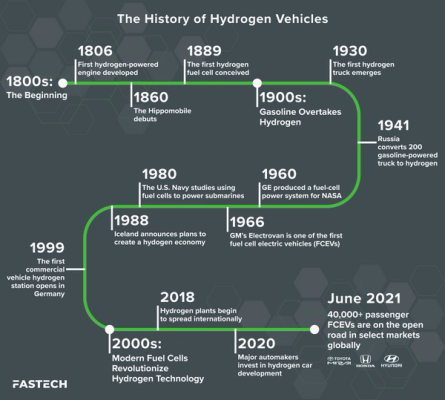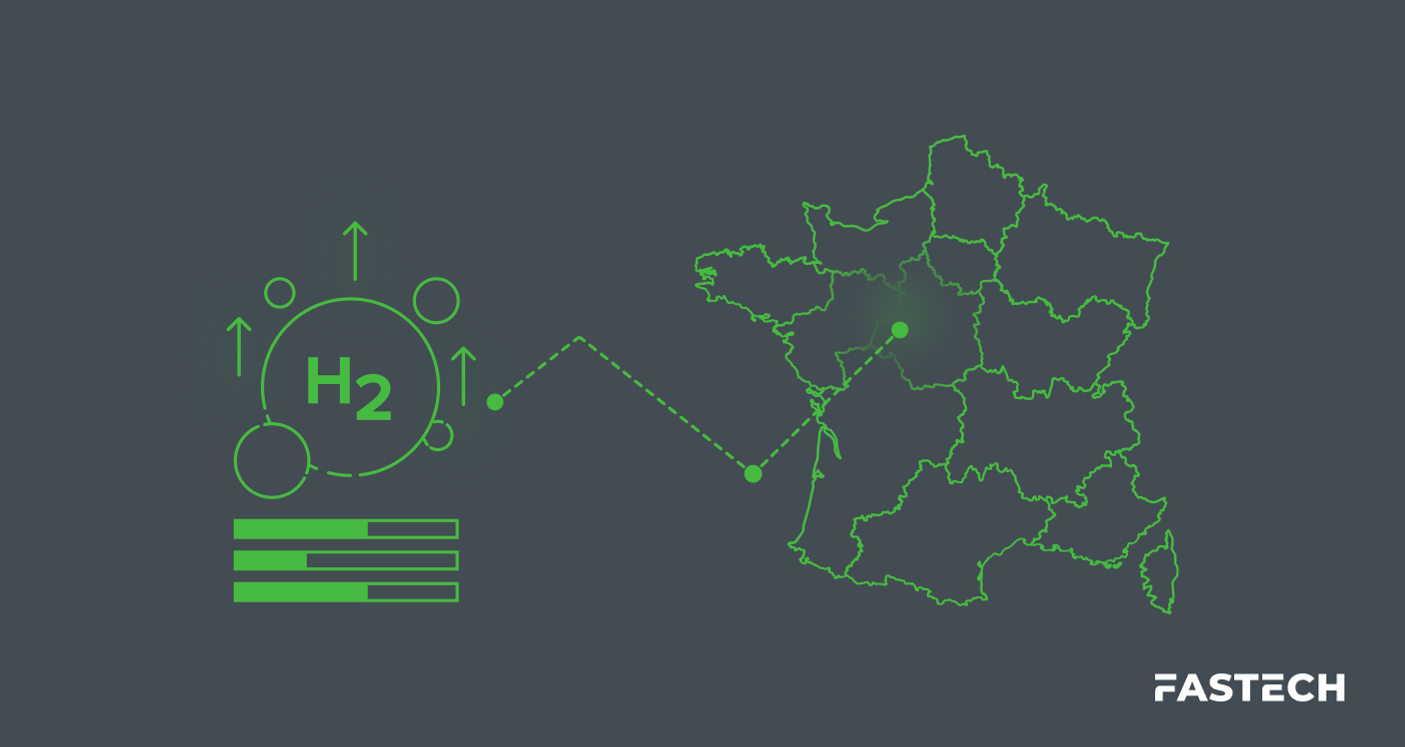The Past, Present and Future of Hydrogen Vehicles

You may have begun seeing hydrogen-powered vehicles on the road recently. But did you know that the first hydrogen cars date back to the 1800s?
Hydrogen mobility is a promising complement to public and commercial transportation, bridging gaps left by internal combustion engines (ICEs) and all-electric vehicles.
Today, hydrogen mobility is starting to get the attention it deserves, but the technology has been in the making for centuries. Let’s explore the humble beginnings of the first hydrogen car, how far the science has advanced, and what to expect in the future.

1800s: A Spark of Inspiration
1806: The First Hydrogen Engine
The first internal combustion engine was powered not by gasoline but by a mix of hydrogen gas and oxygen.
In 1806, Swiss inventor Francois Isaac de Rivaz developed a hallmark technology still applied in modern mechanics. The “de Rivaz engine” held gaseous hydrogen in a balloon and even featured an electric starter for ignition.
The following year, de Rivaz successfully installed his ICE in a carriage and drove it a short distance, piloting the earliest proof of concept for hydrogen transportation.
1860: The Hippomobile Runs on Electrolyzed Hydrogen
In 1860, Belgian-French engineer Étienne Lenoir developed the first functional hydrogen car. Lenoir’s three-wheeled vehicle—dubbed the Hippomobile—ran on hydrogen produced by electrolyzing water before later switching to petroleum fuel.
Lenoir eventually sold hundreds of Hippomobiles, setting the stage for Karl Benz to patent a more practical car in 1886.
1889: The First Hydrogen Fuel Cells (HFCs)
While the first fuel cell was designed in 1839, the term “fuel cell” didn’t exist until 1889 when it was coined by Ludwig Mond and Charles Langer. Their prototype used a coal gas battery and platinum electrodes to generate electricity, a groundbreaking step toward our modern HFCs.
The 1900s: Hydrogen Takes a Back Seat to Gasoline
While experiments with hydrogen-powered vehicles continued throughout the 20th century, gasoline quickly dominated the automotive industry. Nevertheless, innovations in hydrogen continued.
The 1930s: New Approaches to Hydrogen
Fast-forward to 1933 and the birth of the next hydrogen vehicle.
Norwegian power company Norsk Hydro developed a truck that used an internal combustion engine propelled by hydrogen produced from an onboard ammonia reformer.
British engineer Francis T. Bacon developed a five-kilowatt fuel cell later that decade. His invention would be the first to approximate the modern FC stacks seen today.
1941: Gas Shortages Fuel Hydrogen Progress
In 1941, Russia’s Army was under siege and cut off from petrol supply lines. To maintain mobility, they converted 200 trucks to run on hydrogen, inadvertently demonstrating the fuel source’s ability to burn cleaner and last longer than fossil fuels.
1959: Fuel Cells Arrive
In 1959, an alkaline fuel cell tractor with two horsepower became the world’s first FC vehicle.
Then, in the early 1960s, General Electric (GE) produced a fuel cell power system for NASA’s Gemini V spacecraft. To this day, these hydrogen fuel cells provide drinking water for space crews during flight.
1966: General Motors Paves the Way
In 1966, General Motors produced the world’s first recorded HFC vehicle, the GM Electrovan. Its design used a modest 5 kW fuel cell that combined liquid oxygen with supercooled hydrogen. The Electrovan was also the first to use an FC to power a vehicle’s wheels directly.
The 1970s: Environmental Concerns Prompt Efficiency Efforts
Concerns about air pollution and fuel shortages prompted innovations in clean energy. While HFC cars were largely one-off demonstrations, automotive manufacturers experimented with fuel cell electric vehicles (FCEVs) and advanced hydrogen storage technology.
The 1980s: Transport Applications Grow
The U.S. Navy began studying the use of fuel cells in submarines to utilize their efficient and covert operational qualities. Research revealed that submarines powered by fuel cells could remain undetected underwater for up to three weeks.
1998: Iceland Goes Big on Hydrogen
In 1998, Iceland announced its plan to create a hydrogen economy, the first of its kind. The government committed to converting all public transportation vehicles to FC alternatives over ten years.
1999: Europe Explores Fuel Cell Technology Development
In 1999, the first commercial hydrogen station for trucks and cars opened in Germany.
Meanwhile, DaimlerChrysler introduced its liquid hydrogen vehicle, the NECAR 4, to critical acclaim.
The 2000s: Modern Fuel Cells Revolutionize Hydrogen Technology
As the new millennium began, concerns over emissions, efficiency and energy security started to surface. Increased focus on reducing dependence on fossil fuels was a catalyst for revisiting the development of fuel cells as a sustainable energy source.
Hydrogen-Powered Public Transportation Goes Global
In 2018, Norway, China and parts of the UK deployed fuel cell buses and other hydrogen vehicles.
By this time, hydrogen hubs had formed throughout the EU, enabling some countries to produce and export hydrogen fuel. Although Iceland’s bold initiatives for a hydrogen economy stalled, the idea gained traction.
Major Automakers Make Investments in Hydrogen Car DevelopmentThe push for alternative fuels has continued to spark interest in HFC technology. This trend has prompted automakers like Toyota, Hyundai and BMW to keep developing hydrogen fuel cell vehicles.
These makes and models (available in select markets) include:
- Toyota Mirai (released in 2014)
- Hyundai Nexo (released in 2018)
- Honda FCX Clarity (produced from 2016 to 2021)
In addition, newer hydrogen cars in development include:
- BMW iX5
- Honda CR-V FCEV
- Hyundai Staria Fuel Cell
- Ineos Grenadier FCEV
- Kia FK/Hyundai FK
- Kia Carnival FCEV
- Load Rover Defender
- Range Rover FCEV
- Toyota Hilux Hydrogen
As of 2025, the HFC vehicle market is valued at $8.31 billion USD, with a forecasted growth rate (CAGR) of nearly 20% over the next five years.
Fuel Cell Costs Decrease
According to the U.S. Department of Energy (DOE), fuel cell costs have fallen by 80% since 2002. They also reported that further developments in fuel cell technology could make hydrogen car prices affordable to the average consumer within a decade.
As hydrogen continues to trend toward cost parity with fossil fuels, more public and private organizations are exploring hydrogen’s potential.
The Future of Hydrogen Vehicles
It may take longer for consumer HFC vehicles to become mainstream, primarily due to infrastructure limitations.
However, studies reveal that people favor hydrogen as a clean energy source, highlighting a shift in public opinion. In addition, the market for heavy-duty and mass transit vehicles powered by hydrogen is promising.
With global attention turning toward hydrogen, exploring its benefits to energy infrastructure is more critical than ever.
Having partnered with innovators at Shell, Toyota and FuelCell Energy to build alternative energy solutions, FASTECH is America’s leading authority in hydrogen infrastructure.
Our EPC+M experts can help sustainably fuel your operations with the natural power of hydrogen.
Contact FASTECH to learn more about the power of clean hydrogen.




